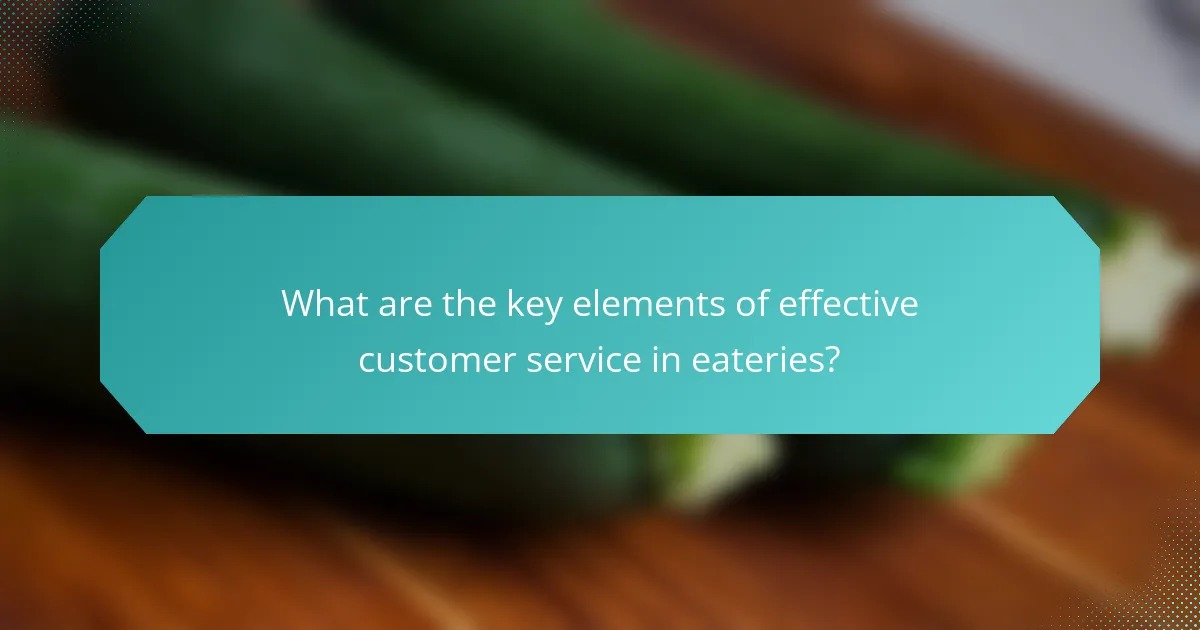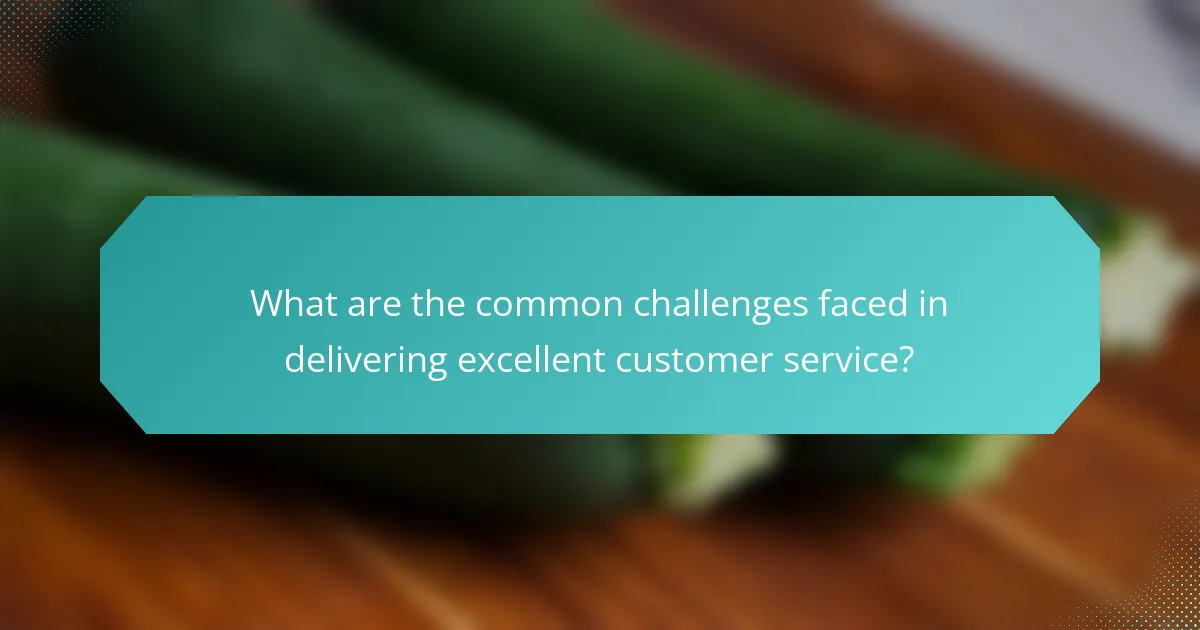Customer service experiences in top-rated New York eateries are characterized by personalized attention, prompt service, and a welcoming atmosphere. Key factors contributing to positive dining experiences include staff training, attention to detail in service delivery, and responsiveness to customer feedback. Research highlights that high service quality significantly influences customer loyalty, with studies indicating that a majority of diners prioritize service in their overall experience. Common challenges faced by restaurants include communication barriers, inconsistent staff training, and managing high customer expectations, all of which are essential for maintaining a strong reputation in the competitive restaurant industry.

What defines customer service experiences in top-rated New York eateries?
Customer service experiences in top-rated New York eateries are defined by personalized attention and prompt service. Many establishments emphasize staff training to enhance customer interactions. A welcoming atmosphere contributes significantly to positive experiences. Attention to detail, such as menu knowledge and timely food delivery, is crucial. Consistent quality and responsiveness to customer feedback are also important factors. High ratings often reflect a combination of these elements. Research indicates that restaurants with exceptional service see increased customer loyalty and repeat business. According to a study by the National Restaurant Association, 70% of diners consider service quality a primary factor in their dining experience.
How do customer service experiences vary across different types of eateries?
Customer service experiences vary significantly across different types of eateries. Fast food restaurants typically prioritize speed and efficiency. Staff interactions are often brief and focused on quick service. In contrast, casual dining establishments emphasize a more relaxed atmosphere. Here, servers engage more with customers and provide recommendations. Fine dining restaurants deliver an elevated level of service. They often feature highly trained staff who anticipate customer needs and offer personalized attention. Research shows that customer satisfaction ratings are highest in fine dining, with 85% of patrons noting exceptional service quality. Each eatery type shapes its customer service approach based on its business model and target demographic.
What are the common characteristics of exceptional customer service in fine dining?
Exceptional customer service in fine dining is characterized by attentiveness, knowledge, and personalization. Attentiveness involves staff being aware of guests’ needs without being intrusive. Knowledge refers to the staff’s understanding of the menu, wine pairings, and culinary techniques. Personalization is the ability to tailor the dining experience to individual preferences.
Moreover, effective communication is essential. Staff should convey information clearly and confidently. Timeliness is also crucial; orders should be taken and served promptly. Additionally, a welcoming atmosphere contributes to exceptional service. This includes a well-maintained environment and a pleasant ambiance.
Finally, follow-up after the meal enhances customer satisfaction. Asking for feedback shows care and commitment to quality service. These characteristics collectively define exceptional customer service in fine dining establishments.
How does casual dining customer service differ from upscale dining experiences?
Casual dining customer service typically emphasizes a relaxed atmosphere and efficiency. In casual dining, servers often prioritize speed and friendliness. Upscale dining experiences focus on personalized service and attention to detail. In upscale settings, staff are trained to provide a more formal and attentive service. Casual dining may involve less interaction with servers. Upscale dining usually includes more frequent check-ins and tailored recommendations. Research shows that upscale dining establishments often have higher staff-to-guest ratios, enhancing service quality. This difference in service style reflects the overall dining experience and customer expectations in each setting.
Why is customer service crucial for the success of New York eateries?
Customer service is crucial for the success of New York eateries because it directly impacts customer satisfaction and loyalty. In a competitive market, exceptional service differentiates restaurants from their peers. Positive customer experiences lead to repeat business and word-of-mouth referrals. According to a study by the National Restaurant Association, 80% of diners consider service quality a key factor in their dining experience. Moreover, online reviews often highlight service as a significant aspect of customer feedback. High ratings in customer service can enhance a restaurant’s reputation and attract new patrons. Therefore, effective customer service is essential for sustaining growth and profitability in New York’s vibrant dining scene.
What role does customer service play in customer retention?
Customer service is crucial for customer retention. High-quality customer service fosters loyalty and repeat business. Satisfied customers are more likely to return and recommend the establishment. According to a study by Bain & Company, increasing customer retention rates by just 5% can increase profits by 25% to 95%. Additionally, 70% of buying experiences are based on how the customer feels they are being treated. This emphasizes the importance of positive interactions in retaining customers. Effective customer service addresses issues promptly and builds trust. In top-rated New York eateries, exceptional service can differentiate them from competitors, enhancing customer loyalty.
How can outstanding customer service enhance a restaurant’s reputation?
Outstanding customer service enhances a restaurant’s reputation by creating positive dining experiences. When customers receive attentive and friendly service, they are more likely to return. This loyalty can lead to increased word-of-mouth referrals. Research indicates that 70% of consumers will recommend a restaurant after a positive experience. Furthermore, excellent service can lead to higher online ratings and reviews. High ratings on platforms like Yelp and Google can attract new customers. A strong reputation can differentiate a restaurant in a competitive market. Ultimately, outstanding customer service is a key driver of a restaurant’s success and longevity.

What are the key elements of effective customer service in eateries?
Effective customer service in eateries includes promptness, attentiveness, and friendliness. Promptness ensures customers receive timely service, enhancing their dining experience. Attentiveness involves staff being aware of customer needs and responding appropriately. Friendliness creates a welcoming atmosphere, encouraging repeat visits. According to a survey by the National Restaurant Association, 80% of customers value friendly service. These elements contribute to overall customer satisfaction and loyalty in the competitive restaurant industry.
How do staff training and engagement influence customer service quality?
Staff training and engagement significantly enhance customer service quality. Well-trained staff possess the necessary skills and knowledge to address customer needs effectively. This leads to quicker problem resolution and improved customer satisfaction. Engaged employees are more motivated and attentive, fostering a positive atmosphere for customers. Research shows that companies with high employee engagement see a 21% increase in profitability. Furthermore, satisfied employees often translate to satisfied customers, creating a cycle of positive experiences. In top-rated New York eateries, this relationship is critical for maintaining high service standards and customer loyalty.
What training methods are most effective for improving service skills?
Role-playing and simulation training are effective methods for improving service skills. These methods allow employees to practice real-life scenarios in a controlled environment. Studies show that role-playing enhances communication and problem-solving abilities. Additionally, interactive workshops promote engagement and retention of service techniques. Feedback sessions following practice scenarios help identify areas for improvement. Research indicates that experiential learning increases confidence in service interactions. Companies that implement these methods often see higher customer satisfaction ratings.
How does employee morale impact customer interactions?
Employee morale significantly impacts customer interactions. High morale leads to more positive, engaging, and efficient service. Employees with high morale are more likely to display enthusiasm and a willingness to help customers. This creates a welcoming atmosphere that enhances customer satisfaction. Conversely, low morale can result in disengagement and poor service quality. Research shows that businesses with high employee morale see a 20% increase in customer satisfaction ratings. This correlation indicates that investing in employee well-being directly benefits customer experiences.
What technological tools are used to enhance customer service experiences?
Technological tools used to enhance customer service experiences include chatbots, CRM systems, and AI analytics. Chatbots provide instant responses to customer inquiries, improving efficiency. CRM systems manage customer interactions and data, helping personalize service. AI analytics assess customer feedback to identify trends and areas for improvement. These tools streamline communication and increase customer satisfaction. According to a study by Salesforce, 70% of customers expect connected experiences across channels. This demonstrates the importance of technology in meeting customer expectations.
How do reservation systems improve customer satisfaction?
Reservation systems improve customer satisfaction by streamlining the booking process. They allow customers to easily secure a table, reducing wait times. This convenience enhances the overall dining experience. Additionally, reservation systems provide confirmation notifications, which reassure customers of their booking. They also allow restaurants to manage capacity effectively, ensuring a pleasant atmosphere. According to a study by OpenTable, 94% of diners prefer to make reservations online. This preference indicates that efficient reservation systems meet customer expectations. Moreover, personalized booking options can enhance customer loyalty.
What role do mobile apps play in streamlining customer service?
Mobile apps significantly enhance customer service by providing immediate access to information and assistance. They allow customers to place orders, make reservations, and access menus quickly. This reduces wait times and improves overall efficiency. Additionally, apps enable direct communication between customers and service staff. Customers can provide feedback instantly, which helps restaurants address issues promptly. According to a study by the National Restaurant Association, 70% of diners prefer using mobile apps for ordering and payments. This preference indicates that mobile apps are essential tools for improving customer satisfaction in restaurants.

What are the common challenges faced in delivering excellent customer service?
Common challenges in delivering excellent customer service include communication barriers, staff training issues, and high customer expectations. Communication barriers can lead to misunderstandings between staff and customers. This often results in dissatisfaction. Staff training issues can cause inconsistent service quality. When employees are not adequately trained, they may struggle to meet customer needs. High customer expectations create pressure on staff to perform. Customers often expect quick resolutions and personalized service. Additionally, managing customer complaints effectively is a challenge. A study by the American Express Global Customer Service Barometer found that 33% of customers would consider switching companies after just one instance of poor service. These challenges are critical for top-rated eateries in New York to address for maintaining their reputation.
How do high customer expectations affect service delivery?
High customer expectations significantly impact service delivery by increasing the pressure on service providers to meet and exceed those expectations. When customers expect high-quality service, they often demand promptness, attentiveness, and accuracy. This can lead to heightened stress for staff, which may affect their performance. Research by the American Customer Satisfaction Index shows that businesses that fail to meet customer expectations can experience a decline in customer loyalty and revenue. Additionally, a study published in the Journal of Service Research indicates that exceeding customer expectations can lead to positive word-of-mouth and repeat business. Therefore, high expectations necessitate a consistent and exceptional level of service to maintain customer satisfaction and loyalty.
What strategies can eateries implement to manage customer expectations?
Eateries can manage customer expectations by clearly communicating menu items and wait times. Providing accurate descriptions helps customers understand what to expect. Training staff to deliver consistent service can enhance customer satisfaction. Regularly updating customers on their order status keeps them informed. Implementing feedback systems allows eateries to address concerns promptly. Offering realistic timelines for service can prevent disappointment. Utilizing social media to share updates and promotions can engage customers effectively. These strategies contribute to a positive dining experience, fostering customer loyalty.
How can restaurants effectively handle customer complaints?
Restaurants can effectively handle customer complaints by actively listening to the customer. Acknowledging the issue shows customers that their concerns are valued. Responding promptly can prevent escalation and demonstrate commitment to service. Offering solutions or compensations, such as refunds or discounts, can help resolve the situation. Training staff in conflict resolution is essential for consistent handling of complaints. Following up with customers after the resolution can enhance their experience and loyalty. Research indicates that 70% of customers who have their complaints resolved will return to the business. This underscores the importance of effective complaint management in maintaining customer relationships.
What are the best practices for creating memorable customer service experiences?
Best practices for creating memorable customer service experiences include personalization, timely responses, and active listening. Personalization involves addressing customers by name and tailoring interactions to their preferences. Timely responses ensure that customer inquiries are handled quickly, improving satisfaction. Active listening allows staff to understand customer needs fully, which enhances service quality.
Additionally, training staff in empathy and problem-solving is crucial. Empathetic staff can connect with customers on a personal level. Problem-solving skills enable staff to address issues effectively.
Consistent follow-up after service interactions can also enhance the experience. This shows customers that their opinions matter and fosters loyalty. According to a study by the American Express Global Customer Service Barometer, 70% of Americans are willing to spend more with companies that provide excellent customer service.
How can personalization enhance the dining experience?
Personalization enhances the dining experience by tailoring services to individual preferences. This customization can include menu options, seating arrangements, and service styles. When diners receive personalized recommendations, they feel valued and understood. A study by Deloitte found that 80% of consumers are more likely to make a purchase when brands offer personalized experiences. Additionally, personalized dining experiences can lead to higher customer satisfaction and loyalty. This is evident in top-rated New York eateries, where personalized service often results in repeat visits. Overall, personalization creates a memorable dining atmosphere that fosters connection between diners and the establishment.
What are some successful examples of customer service in top-rated eateries?
Successful examples of customer service in top-rated eateries include personalized dining experiences and attentive staff. At Eleven Madison Park, waitstaff remembers regular customers’ preferences. This enhances the dining experience and fosters loyalty. In Le Bernardin, the staff is trained to anticipate needs, ensuring timely service. Customers often report feeling valued and respected. At Katz’s Delicatessen, the quick service during busy hours demonstrates efficiency. The staff engages with customers, creating a welcoming atmosphere. These practices contribute to high customer satisfaction ratings and repeat visits.
What tips can enhance customer service experiences in New York eateries?
To enhance customer service experiences in New York eateries, staff training is essential. Properly trained staff can effectively handle customer inquiries and complaints. Quick response times significantly improve customer satisfaction. Offering personalized service creates a memorable dining experience. Maintaining a clean and inviting atmosphere is crucial for customer comfort. Regular feedback collection helps identify areas for improvement. Utilizing technology, such as reservation systems, streamlines the dining experience. Finally, recognizing loyal customers fosters long-term relationships and repeat business.
Customer service experiences in top-rated New York eateries are characterized by personalized attention, prompt service, and a welcoming atmosphere. Key elements include staff training, attention to detail, and responsiveness to customer feedback, which significantly impact customer satisfaction and loyalty. The article explores how customer service varies across different types of eateries, the characteristics of exceptional service in fine dining, and the importance of effective complaint management. Additionally, it discusses the role of technology and staff engagement in enhancing service quality, as well as best practices for creating memorable customer experiences.
